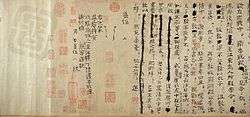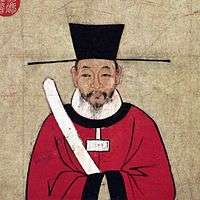Zizhi Tongjian
|
Section from one of the original scrolls of the Zizhi Tongjian | |
| Author | Sima Guang et al. |
|---|---|
| Original title | 資治通鑑 |
| Country | China |
| Language | Classical Chinese |
| Subject | History of China |
Publication date | 1084 |
| Media type | Scrolls |
The Zizhi Tongjian (Tzu-chih Tung-chien; simplified Chinese: 资治通鉴; traditional Chinese: 資治通鑑; pinyin: Zīzhì Tōngjiàn; Wade–Giles: Tzu1-chih4 T'ung1-chien4; literally: "Comprehensive Mirror in Aid of Governance") is a pioneering reference work in Chinese historiography, published in 1084 AD, in the form of a chronicle. In 1065 AD, Emperor Yingzong of Song ordered the great historian Sima Guang (1019–1086 AD) to lead with other scholars such as his chief assistants Liu Shu, Liu Ban and Fan Zuyu,[1] the compilation of a universal history of China. The task took 19 years to be completed,[1] and, in 1084 AD, it was presented to his successor Emperor Shenzong of Song. The Zizhi Tongjian records Chinese history from 403 BC to 959 AD, covering 16 dynasties and spanning across almost 1,400 years,[1] and contains 294 volumes (巻) and about 3 million Chinese characters.
The text

The principal text of the Zizhi Tongjian was recorded on 294 juan (Chinese: 卷), which are scrolls corresponding to a volume, chapter, or section of the work. The text is a chronological narrative of the history of China from the Warring States to the Five Dynasties. The major contributor, Sima Guang, was active in each step from collecting events and dates from various previous works to drafting and publication.
Sima Guang left the traditional usage in Chinese historiography. For almost 1,000 years since the Shiji was written, standard Chinese dynastic histories had primarily divided chapters between annals (紀) of rulers, and biographies (傳) of officials. In Chinese terms, the book changed the format of histories from biographical style (Chinese: 紀傳體) to chronological style (Chinese: 編年體), which is better suited for analysis, activism and criticism. According to Wilkinson: "It had an enormous influence on later Chinese historical writing, either directly or through its many abbreviations, continuations, and adaptations. It remains an extraordinarily useful first reference for a quick and reliable coverage of events at a particular time."[2]
The 294 juan sweep through 11 Chinese historical periods (Warring States, Qin, Western Han, Eastern Han, Three Kingdoms, Jin and the Sixteen Kingdoms, Southern and Northern Dynasties, Sui, Tang, and Five Dynasties). It was one of the largest historical magna opera' in history.
Derivative and commented works
In the 12th century, Zhu Xi produced a reworked, condensed version of Zizhi Tongjian, known as Tongjian Gangmu, or Zizhi Tongjian Gangmu (通鑒綱目). This condensed version was itself later translated into Manchu as ᡨᡠᠩ
ᡤᡳᠶᠠᠨ
ᡬᠠᠩ
ᠮᡠ Wylie: Tung giyan g'ang mu, Möllendorff: Tung giyan g'ang mu, upon the request of Qing Dynasty Kangxi Emperor. This Manchu version was itself translated into French by French Jesuit missionary Joseph-Anna-Marie de Moyriac de Mailla. His twelve-volume translation, "Histoire générale de la Chine, ou Annales de cet Empire; traduit du Tong-kien-kang-mou par de Mailla" was published posthumously in Paris in 1777-1783.[3]
The Zhonghua Shuju edition contains textual criticism made by Yuan Dynasty historian Hu Sanxing.
Sections of Zizhi Tongjian pertaining to China's relations with the Xiongnu have been translated into English.[4]
Contents

The book consisted of 294 volumes, of which the following number describe each respective dynastic era:
- 5 volumes - Zhou (1046-256 BC)
- 3 volumes - Qin (221-207 BC)
- 60 volumes - Han (206 BC-220 AD)
- 10 volumes - Wei (220-265)
- 40 volumes - Jin (265-420)
- 16 volumes - Liu Song (420-479)
- 10 volumes - Qi (479-502)
- 22 volumes - Liang (502-557)
- 10 volumes - Chen (557-589)
- 8 volumes - Sui (589-618 AD)
- 81 volumes - Tang (618-907)
- 6 volumes - Later Liang (907-923)
- 8 volumes - Later Tang (923-936)
- 6 volumes - Later Jin (936-947)
- 4 volumes - Later Han (947-951)
- 5 volumes - Later Zhou (951-960)
See also
Notes
- 1 2 3 Xu Elina-Qian, p.20
- ↑ Wilkinson (2000:499)
- ↑ Chinese Literature: Tongjian gangmu 通鑑綱目 Archived October 11, 2007 at the Wayback Machine
- ↑ Yap (2009)
| Chinese Wikisource has original text related to this article: |
References
- Chen, Guangchong, Zizhi Tongjian ("Comprehensive Mirror to Aid in Government"). Encyclopedia of China (Chinese History Edition), 1st ed.
- Bo Yang. Modern Chinese Edition of Zizhi Tongjian. Taipei: Yuan-Liou Publishing Co. Ltd, vol. 1 ISBN 957-32-0795-8 to vol. 72 ISBN 957-32-1810-0.
- De Crespigny, Rafe. (1973). "Universal Histories," in Essays on the Sources for Chinese History, Donald D. Leslie, Colin Mackerras, Wang Gungwu, eds., Columbia: University of South Carolina Press, pp. 64–70.
- Ji xiao-bin. (2003). "Mirror for Government: Ssu-ma Kuang's Thought on Politics and Government in Tzu-chih t'ung-chien," in The New and the Multiple, Thomas H.C. Lee, ed. Hong Kong: Chinese University Press, pp. 1–32.
- Partington, James Riddick (1960). A History of Greek Fire and Gunpowder. Cambridge: W. Heffer & Sons Ltd.
- Wilkinson, Endymion. 2000. Chinese History: a manual. Revised and enlarged ed. Cambridge: Harvard University Asia Center. ISBN 0-674-00249-0
- Yap, Joseph P. (2009). Wars With The Xiongnu, A Translation from Zizhi tongjian. AuthorHouse, Bloomington, Indiana, U.S.A. ISBN 978-1-4490-0604-4.
External links
- Xu Elina-Qian, Historical Development of the Pre-Dynastic Khitan, University of Helsinki, 2005. 273 pages. 2.1 Introduction to the Sources on the Pre-dynastic Khitan (pp.19-23) > The Zizhi Tongjian, p.20
- Zizhi Tongjian (original text in Guoxue)
